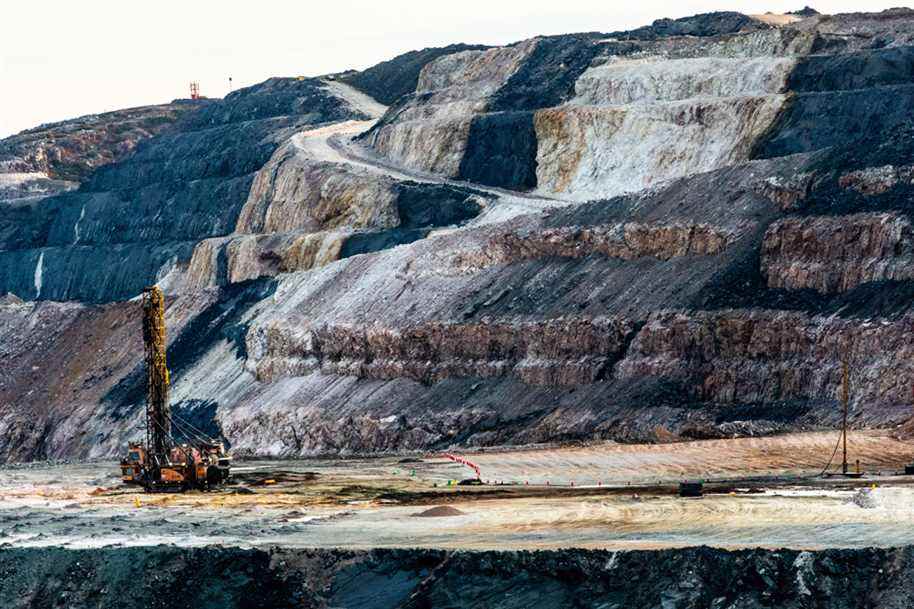Noxious spills, “false or misleading” statements, incomplete reports and omission of tests: ArcelorMittal multiplied environmental offenses a decade ago at the Mont-Wright mining complex on the North Shore, ruled the Court of Quebec.
The Canadian subsidiary of the Luxembourg-based steel giant has been convicted of more than 90 charges laid under the Fisheries Act as well as the Metal Mining Effluent Regulations, concludes Judge Julie Riendeau, in her judgment rendered last October. It is more than 90% of the charges which had been laid against him.
The charges took place from 2011 to 2013 and are grouped into six categories of offenses.
It is impossible for the moment to know what sanction will be imposed on the multinational, which has appealed the decision. The case is due to return to court on Monday. Sentencing observations are expected to take place in 2022.
ArcelorMittal was notably found guilty of being responsible for the release of a “harmful substance” in Lake Webb, south of the complex, “into waters where fish live”. The concentration of mining effluents – tailings that may contain toxic substances – exceeded the limit of the regulatory framework.
“Everyone agrees that materials are harmful substances for the purposes that concern us,” writes Judge Riendeau, in her 74-page judgment where it is indicated that a warning had been given in November 2010.

PHOTO MARTIN TREMBLAY, PRESS ARCHIVES
The Mont-Wright mine has reserves for another three decades, according to ArcelorMittal.
In Quebec, in 2014, the American company Cliffs Natural Resources – operator of the Bloom Lake mine at the time – was fined 7.5 million following hundreds of violations of the Fisheries Act. Last March, the Teck Coal mining company was fined $ 60 million – the largest of its kind – for spills in two rivers in British Columbia.
The Mont-Wright mine, which began operations in 1974, is the largest surface iron deposit in Canada. It has reserves for another three decades, according to ArcelorMittal.
Case by case
The company’s employees take samples to measure the concentration of mining effluents. They are analyzed internally as well as in an external laboratory. The results must then be transmitted to the federal authorities.

PHOTO MARTIN TREMBLAY, PRESS ARCHIVES
Transport trucks at the Mont-Wright mine
According to the Crown, ArcelorMittal selected the results transmitted to Environment and Climate Change Canada (ECCC), a practice that “disguises” the reports. The company replied that it had acted in this way after being misled by the directives of an inspector of the Ministry “as to the results to be transmitted”.
“ECCC can only have an inaccurate, distorted picture of the situation in the circumstances”, observes Judge Riendeau, about ArcelorMittal’s transmission methods.
The decision of the Court of Quebec underlines that a witness said, during the trial, that he was no longer “comfortable” to “continue the practice” which consists in declaring only the result which meets the standards when more than one sample was taken in the same week.
On this point, the defense replied that certain tests were voluntary environmental verifications, which did not have to be submitted.
“The argument of the accused is disconcerting, writes Judge Riendeau. Indeed, to adopt it would be equivalent to concluding that the samples and analytical results declared to ECCC would be valid, while the others would not be valid since they are under the guidance of voluntary environmental verifications. ”
Far from over
ArcelorMittal declined to comment on the content of the judgment because of the appeal, said spokesperson Annie Paré.
Last Tuesday, the company published a “corporate manifesto” in which it stressed that it was necessary to “recognize” and “respect” the territory where it is established.
“This decision relates to events that took place between 2011 and 2013,” wrote Mr.me Ready. Know that environmental protection and sustainable development are fundamental values within our organization. ”
Ugo Lapointe, coordinator of the Quebec Better Mine Coalition, believes that the “robust” and “very negative” judgment against ArcelorMittal grazes its image when the multinational is trying to present itself as “the greenest steel mill. internationally “.

PHOTO FROM UGO LAPOINTE’S LINKEDIN ACCOUNT
Ugo Lapointe, coordinator of the Quebec Better Mine Coalition
If it wants to act responsibly, the company should stop wasting taxpayers’ time and money by contesting the offenses alleged against it by the Ministry of the Environment and which are clearly recognized by the court.
Ugo Lapointe, coordinator of the Quebec Better Mine Coalition
In this case, a numbered company was also convicted of five counts. The first shareholder of this company is EQP Cooperatief, established in the Netherlands. It was associated with ArcelorMittal from February 2013. According to the judgment, it owned 15% of the Canadian subsidiary of the multinational with other investors.
The legal process began in 2017. The trial took place on an ad hoc basis for seven months in 2020 and ended on February 19.
With the collaboration of André Dubuc, Press
205 million
Amount that will be invested by ArcelorMittal in its Port-Cartier plant to modify its iron pellets production process in 2025 and reduce its greenhouse gas emissions. The investment is accompanied by an electricity rebate of around 80 million.

